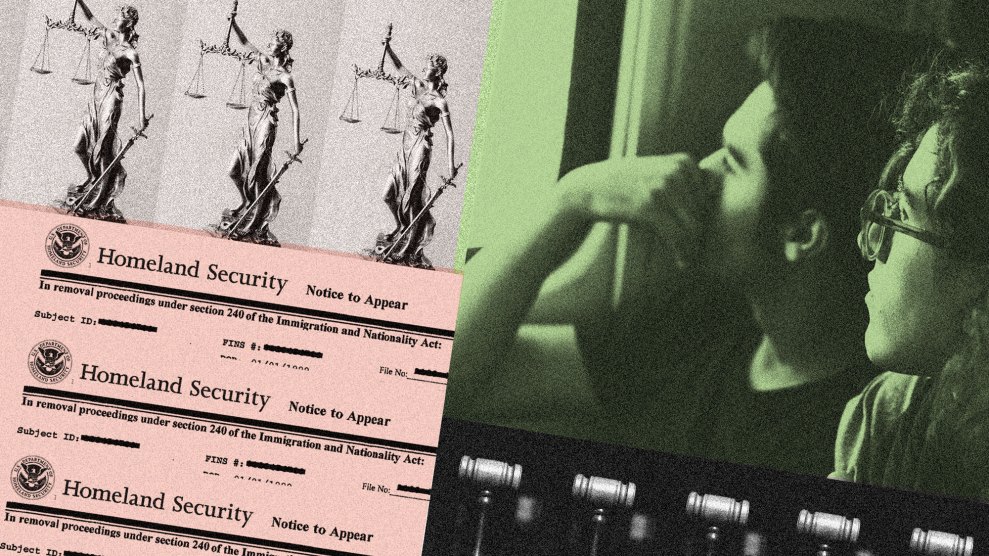
Mother Jones illustration; Unsplash
For years, under multiple presidents of both parties, the immigration court system has been something of a mess, struggling with a huge backlog of cases that has just seemed to snowball and snowball, sometimes keeping individuals in legal limbo for several years. Now new data shows the backlog of cases in immigration court has reached the highest level ever—at almost 1.6 million, according to a recent report from the Transactional Records Access Clearinghouse (TRAC) at Syracuse University. And it’s not just that more cases are being added because more people are trying to either request asylum or enter the US illegally. Changing politics actually have a lot to do with it, and it’s been a constant challenge for immigration judges, lawyers, and immigrants themselves to survive the whiplash.
While talking about court backlogs can seem abstract or too in the weeds, each of these cases has a person’s future at stake; it can determine whether someone gets deported, is granted asylum, is released from a detention center, or is given a green card. In short, each case determines if someone can plant roots. An immigration attorney tweeted this week that his client had waited four years for his first hearing, which was set for February 2, 2022, but had now been moved to April 2025. In light of the overwhelming new numbers, I recently spoke with people who work in immigration court to help unpack how we got here and how we could possibly fix this seemingly intractable problem. Here, I break down what’s going on with the courts in what I hope is the least wonky way possible.
The size of the backlog is breaking records—and so is the pace at which it’s growing
To put the 1.6 million cases in perspective, the backlog is split between approximately 560 judges hearing cases at 70 immigration courts throughout the United States and its territories. Each judge would have to hear more than 2,800 cases to get the pipeline to zero, and that’s if no new cases were added. But, of course, that's not the reality—and based on the data recently released by TRAC, many more cases are going to be added soon.
"A disturbing new trend has emerged during the Biden administration that demands attention," the TRAC report said. "The growth of the backlog has been accelerating at a breakneck pace." The quarterly growth in the number of pending cases between October and December 2021 is the largest on record, adding almost 140,000 new cases and far exceeding any three-month increase even in the Trump administration, when the backlog grew at a rate faster than in the previous two administrations. "These findings suggest that the Immigration Courts are entering a worrying new era of even more crushing caseloads," the report explained. "All the more concerning since no attempt at a solution has yet been able to reverse the avalanche of cases that immigration judges now face."
According to TRAC, the partial court shutdowns during the pandemic have contributed to the backlog’s growth. But the main contributor in recent months is the "deluge of new cases filed by the Department of Homeland Security." If new cases continue to grow at this pace, "the court will receive 800,000 new cases—at least 300,000 more than the annual total the court has ever received during its existence." Frustratingly, the people I spoke with didn't know why this was, and DHS did not respond to a request for comment.
Immigration court is not like the courtrooms in Law & Order
A key reason why we ended up here in the first place, immigration judge Mimi Tsankov told me, is that judges in immigration court do not operate like most other judges. "People have this perception about what they see on TV where they likely see judges who have a lot of power in the courtroom," Tsankov said. "We don’t have the same kind of power."
Unlike the judges you usually think about, immigration judges are employees of the Department of Justice and the courts are overseen by the Executive Office for Immigration Review, under the US attorney general.
Tsankov is a judge in the New York immigration court and spoke to me in her capacity as president of the immigration judges union, the National Association of Immigration Judges (NAIJ). She explained that judges can’t control what cases they see or in what order. They have no say in who their clerks are and what their staff should be working on. "Our managers can say, ‘We gave you staff person X, but we need that person to work on a project for three weeks,'" she said. This often translates into missing or delayed filings, judges not getting the right documents on a case before a hearing, or attorneys not getting their questions answered or their messages returned, which leads to delays.
Dockets are determined by politicians, not judges
Another reason judges can’t finish their cases is that the priorities in their dockets change every time there’s a new president in the White House. Tsankov explained it this way: "If I have 2,700 cases that are assigned to me and I have a way I’d like to schedule them out over the next three years, because I don't control my docket, a manager can come along and say, ‘Sorry judge, we’re going to take six months worth of your cases and we’re going to put those at the end of your docket and now we’re going to give you six months worth of new cases.’ And of course none of them have attorneys yet so that causes major delays in trying to resolve the cases that are constantly being shifted around."
Since the courts fall under the executive branch, cases get shifted before they're completed because "each new administration that comes into power has their own priorities. That person decides what the laws and the priorities are going to be," Tsankov noted. So one president can choose to prioritize the cases of, let’s say, asylum seekers who have been waiting for years in the United States, while a new administration can direct the DOJ to instead front load and try to quickly close the cases of people who have just been apprehended at the border. Further complicating this setup, a judge's ruling can also be appealed by DHS or the attorney general can even overrule a judge.
In late January, Tsankov spoke in a congressional hearing with the House Judiciary Subcommittee on Immigration and Citizenship in support of an independent immigration court, along with representatives from the Federal Bar Association and the American Bar Association. Tsankov said that the DOJ’s control over the courts "has yielded extreme pendulum swings" that have judges "reeling as they navigate their judicial responsibilities on the one hand and heavy political scrutiny."
She’s not the first to say this. For several years now, the NAIJ has been asking for independence from the DOJ so judges can be free of political pressures. Not only has their request not been granted, the Trump administration actually went after the judge’s union—asking the Federal Labor Relations Authority in 2019 to decertify it. The union has been in existence since 1979. Just last month the FLRA voted to strip the union of its certification, something the NAIJ is planning to appeal. Tsankov called this a "union busting effort by a politically minded group that really wants to silence the immigration judges."
"I don't understand the threat that the organization presents," she added. "We are calling for a good governance solution."
There is a problem of resources, resources, and more resources
There seems to be a disconnect in the US immigration system between the enforcement side and the judicial side, as longtime immigration judge Dana Marks brought up in an NPR interview last year. The budgets for the DHS agencies that put people in immigration court proceedings (Customs and Border Protection and Immigration and Customs Enforcement) are astronomical and just keep growing, but the budget increases to immigration courts have not grown at a matching pace. In recent years, both the Trump and the Biden administrations have added more judges to the courts to help clear the backlog. But more judges alone can’t make a significant dent without more court staff, not to mention consistent political priorities.
As Tsankov told me, the issue is both the lack of resources and the misallocation of resources. And this manifests in ways that seem mundane but have significant impact: It's not having the right staff to answer the phones and respond to voicemails, or to sort mail that is full of documents relevant to people’s cases; it's also not having enough laptops for judges to hold virtual court hearings outside of their courtrooms during the pandemic. Tsankov said there are only about 100 laptops available among all the judges, meaning only 20 percent of judges can hold court virtually.
The bureaucratic nightmare for judges is equally felt by immigration lawyers, like Florida-based Chelsea Nowel. She told me she constantly struggles to communicate with the court clerks, get status updates on her cases, and more. It's like having a sentenced case "run in a traffic court," she said.
The long wait times create several layers of "chaos"
The time it takes to resolve immigration cases is a challenge that compounds so many of the other challenges in the system. Changes in immigration law "happen constantly and sometimes without warning," Nowel told me. Someone may be preparing their case for years but is now no longer eligible. "We saw this a lot during the previous administration, if their case had happened sooner they may have been approved, but now all of the sudden they’re going to be denied." But at this point, they've already sometimes waited years in the system.
Immigration court is "absolute chaos," as Nowel put it.
At the individual level, the massive backlog creates "a ton of extended anxiety and fear," Nowel added. Waiting so long to close immigration cases means that her clients are “never truly settled, they’re never confident, they don’t know what’s going to happen next." She said they have to deal with unpredictable changes and last-minute cancellations that take an emotional toll, especially on asylum seekers. This, then, makes their cases harder to adjudicate. "Trauma records different in your memory" as time passes, she said, meaning some people can end up losing details over the years regarding what happened to them, or they’re less able to talk about their trauma because they’ve had to bury it for so long.
One of her cases for a Central American asylum seeker has been rescheduled three times and has been pending for five years, a timeline that is not uncommon. The most "egregious" wait time she has come across is the case of a Palestinian asylum seeker that has been pending for 20 years. "They’ve had children who are US citizens and who have gone to college," she said. The case started in 2003 and got stuck in other branches of DHS before getting caught up in the court backlog, "and they still have not had a court hearing date."
So, what can be done about this mess?
When I asked Nowel why the general public should care about how US immigration courts are run, she argued that the backlog can be seen as another form of family separation: "People were very outraged when they heard about the separation of children and families. This is a similar situation in which families are not able to settle down to make a life for themselves or to be assured that they will not be returned to locations where these horrific and traumatic experiences have happened because of this extensive backlog."
And aside from asylum cases, the backlog affects people who are about to be legal permanent residents, or who are spouses of US citizens who could have gotten their green cards in just a few months, but instead it took a few years—things that Nowel said “could be cleared up really quickly.”
So let’s start with what many see as a crucial first step: free immigration courts from under the DOJ. This would be a huge move to “fix the system,” according to Tsankov, the NAIJ, the Federal Bar Association, the American Immigration Lawyers Association, dozens of human rights organizations, and others judges who have spoken out over the years. What they propose is to create what’s known as an Article I court, which, with congressional approval, would work independently—potentially similar to the US Tax Courts. Doing this, supporters say, would allow judges to manage their own case loads, oversee their staff and resources, and act independently from whatever the White House immigration policy is on any given year.
Recently, Rep. Zoe Lofgren (D-Calif.), chair of the Judiciary Committee's immigration and citizenship subcommittee, introduced a bill that would remove immigration courts from control of the DOJ and the attorney general. The Rule of Law Act of 2022 immediately received a very warm welcome from immigrant rights groups, legal experts, the Federal Bar Association, the American Immigration Lawyers Association, and the NAIJ. The bill would also set hiring standards that would require immigration judges to have at least 10 years experience as attorneys and prior experience with immigration law specifically. (Under the Trump administration, many judges were appointed despite having no immigration law experience.)
Another important change that would help with the backlog and overall due process would be to provide lawyers for every person going through immigration court proceedings. The majority of immigrants navigate the system without representation, even though, for decades, human rights groups, international nonprofits, lawyers, and immigrants themselves have been asking for guaranteed legal representation. The immigration system as a whole is incredibly complex even for people who have lawyers, and inconceivably daunting for those who don't. Unlike in other legal proceedings, if you can't afford an attorney, one won't be provided to you in this court. "Those who appear in Immigration Court are often uneducated in our language, culture and law but are nevertheless required to present their claims unaided, while the DHS is represented by skilled government attorneys," NAIJ has said. "This challenge becomes much more difficult when a respondent is detained."
These steps alone could make a big difference in the future of immigration cases, though Nowel pointed out that to really lower the backlog, there still needs to be more immigration judges and more courtrooms. Until then, Tsankov stressed how important it is that judges have the time to listen carefully and review every piece of evidence, so immigrants "know that the system is a fair one and that they have a real shot."
"By law we are required to give them due process and we take that responsibility very seriously," Tsankov said. "Some of them may not be eligible for the relief but they need to feel that there is a humane process."












